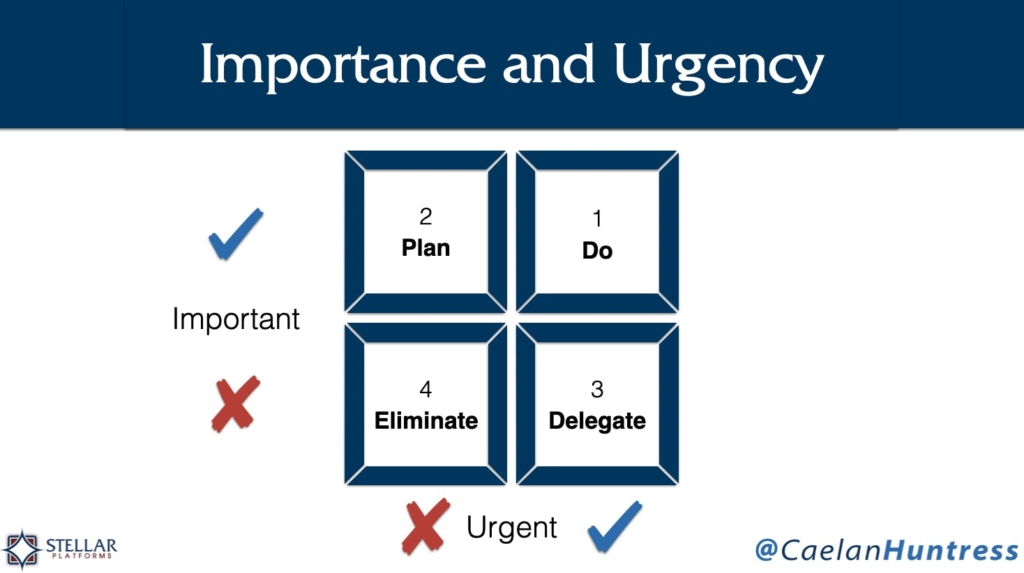As the military general in charge of US operations in Europe during World War II, Dwight Eisenhower had many difficult days. He had to handle shifting priorities in complex, uncertain situations. His leadership was characterized by a keen understanding of the difference between urgency and importance.
“What is important is seldom urgent and what is urgent is seldom important,” he used to say. Sometimes they overlapped, which made four types of priorities, classified in a 2×2 grid that has become known as the Eisenhower Decision Making Quadrant:

These four quadrants can help you sort through your own priorities, and decide what matters most.
Human brains are hardwired to handle alarm.
The phone is ringing. Ding! Another email notification. The washing machine is beeping now that its cycle is done. Are you going to get that? You have to do it now. Right NOW.

Urgent priorities can seem important, because they are immediate. Our fight-or-flight system reacts quickly to the urgent, because we evolved from mammals that were more likely to survive if they could react quickly in the face of danger. Now that we have evolved thousands of generations, we don’t need this survival instinct to make every decision, but we are still predisposed to move fast when urgency is required.
Counterintuitively, urgency can slow you down, because it can keep you from working on what’s actually important. Achieving a high quantity of low quality goals will not make meaningful progress, even when it feels like so much is getting done.
|
|
When Dr Stephen Covey wrote the book First Things First (which was the first of the 7 Habits of Highly Effective People) he described something he called the Urgency Addiction.
“We get a temporary high from solving important and urgent crises,” he said. “Then when the importance isn’t there, the urgency fix is so powerful we are drawn to do anything urgent, just to stay in motion.”
Urgency creates momentum, and that momentum keeps us focused on other urgent things.
To achieve important priorities, sometimes we have to postpone the urgent, which goes against our momentum.
We cannot ignore all urgent priorities, because some of them are also important. But we need to be on guard against urgent, non-important priorities, because they can keep us from accomplishing their opposite: the important, non-urgent priorities that make the biggest impact on our results.
We are prone to ignore the important if it is not urgent.
Imagine you have an empty pitcher that could hold 2 cups of volume inside. I then give you a cup of sand and a cup of rocks, and ask you to fill the jar.
If you pour the sand in first, it will fill the bottom half of the pitcher. The second cup of rocks will fill it up to the brim. But what happens if you pour the big rocks in first? The sand will fill in the empty spaces between the rocks. By starting with the big rocks first, you will have more space at the top of the pitcher, even though you filled it with two cups each time.
The sand is your urgent priorities – the little things you need to do right away. You can fit them in around the other priorities, because there is space. Starting with the big rocks first – those important, non-urgent priorities – ensures they actually get done. Starting your day by working on something that is important, and not urgent, will give you a different type of momentum.

Warren Buffet was once asked by his longtime helicopter pilot how to achieve his goals in life. “Have you written down your goals?” the billionaire asked. The pilot shook his head. Buffet replied, “Write down 25 goals, and bring them to work tomorrow.” (I am paraphrasing this conversation, and possibly embellishing a bit, for dramatic effect.)
“What are the most important 5 goals?” Buffet asked his pilot the next day. “Circle those. If you achieve those five goals, the others don’t matter.” The pilot picked his five, and pledged to focus on working on those goals. “Now, what about the other 20?” Buffet asked.
“I will work on those when I’m not working on the top five,” he said.
“No,” Buffet replied. “The other 20 goals go on your Avoid-At-All-Costs list. You decided that these goals were not as important as the ones in your top 5, and if anything is going to prevent you from achieving what you want, it’s something in that second list.”
“We are kept from our goal not by obstacles, but by a clear path to a lesser goal.” – Robert Brault
What are your most important goals? Are you sacrificing them for urgent, lesser goals?
Look at a list of goals you have written recently. They might be New Year’s Resolutions, or quarterly marketing plans, or a wish list on the back page of your planner.
Identify the important, non-urgent goals that have not been given enough attention. Schedule some time to make progress on those goals, your big rocks, before you fill up the rest of your day with sand.
This article is an excerpt from my next book, Playful Productivity. To get notified when it’s ready, sign up for the wait list here.





Leave A Comment